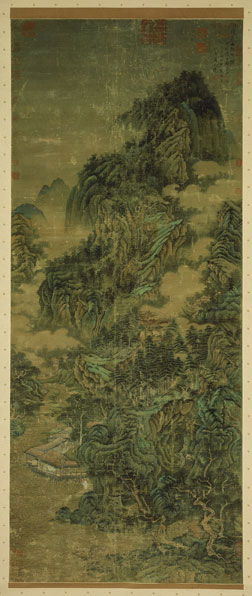In a small room off the main Japanese gallery at the Museum of Fine Arts is a small exhibit on display for the next few months dedicated to the Chinese painter Zhang Daqian. You may be wondering why he was important enough to get his own exhibition in the MFA, or why you should even care. Well, it turns out Zhang is one of the greatest artist you never heard of. Zhang was a master of traditional Chinese style, a well known collector, a pioneer of new techniques and a genius forger.
Zhang began his study of painting in 1941 when he went to Dunhuang, an ancient Silk Roadway point, where he studied some of the earliest Chinese art that exists: cave wall paintings. For two years he lived a monk-like existence, studying the artwork and making replicas with the help of monks as painting assistants. It is believed that it is in Dunhuang where he learned his appreciation for old style and technique.
Zhang went on to become a well-known collector and connoisseur of Chinese paintings. In 1957 he sold his first work to the Museum of Fine Arts in Boston. Well, sort of. The piece he sold to the MFA (via New York art dealer Frank Caro), “Drinking and Singing at the Foot of a Precipitous Mountain,” was supposedly a tenth century work attributed to the painter Guan Tong.
This is the first piece the viewer is greeted by upon entering the gallery, accompanied by letters between the MFA and the dealer outlining the sale. The painting sold for about $40,000. Zhang didn’t just copy an existing art work, rather he used a twelfth century catalog of the Chinese imperial collection to pick an artwork that no longer existed, then create his own version of it. He added seals to the artwork of supposed owners (a Chinese tradition apparently was to place your seal upon an artwork you owned, much like writing “Property of Blank” on a painting you buy) to create a false history. Zhang then mounted the painting on Japanese silk, like a wall scroll, and added silver and copper rollers to create the illusion that it was in the hands of Japanese collectors to explain why there was no record of it in the 19th century. The MFA didn’t find out until relatively recently that many of Zhang’s works were forgeries. After the sale of his first piece, Zhang began selling directly to the MFA.
Zhang’s paintings, both his originals and forgeries, show his mastery and love of traditional Chinese ink painting. He was known for only using traditional tools and materials. The most recognized original of Zhang’s paintings is a landscape entitled “Mount Emei,” which he gave to the MFA as a gift.
Zhang visited the MFA in 1953. During a tour, he was shown a painting with his name on it. He declared it a forgery and immediately gave them the aforementioned landscape so they would have something by him. Ironically, they had already purchased many forgeries by him.
Later in his life, his eyesight began to fail and he pioneered a new technique he called ‘splashed color method.’ Splashed color method calls to memory very thick, but fluid watercolor. The example in the exhibit, “Red Lotus,” was painted in 1981, a year before he died. “Red Lotus” has a single, perfectly drawn flower in a sea of blues and greens. What at first glance appears to be a spilled mess turns into stems and a hazy mountain after a short contemplation.
Zhang was a consummate master and a consummate thief. Now, whenever a Chinese painting finds its way into the MFA’s hands, they have to ask themselves whether or not it could be one of Zhang’s.





















































